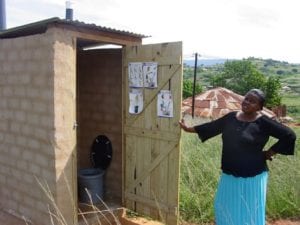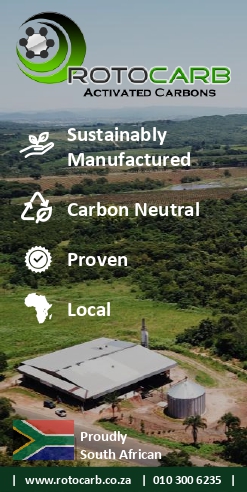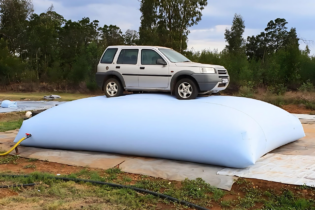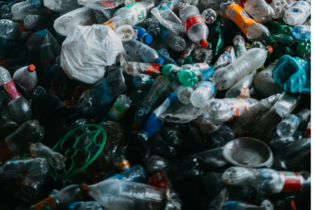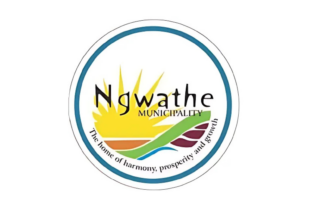eThekweni Municipality is tackling the challenge of providing sanitation and water to its rural and peri-urban communities through the provision of urine diversion toilet. The rollout began with a pilot project in uMzinyathiu, a peri-urban area west of Durban central. Here various designs for sanitation were looked at and the final decision to adopt the UD system was taken. The decision to go with a UD system was taken because of cost considerations and environmental benefits. It is a sealed unit so the groundwater is not impacted. UD technology is based on the principle that by keeping urine and faeces separate, the disease-causing pathogens contained in the faecal matter are destroyed over time, through a drying process. The health study that was initiated in 2006 has been completed. The research indicated significant health benefits and improvements in the community and a reduction in the number of cases of diarrhea. Below is a paper compiled by experts at eThekweni Municipality, which provides full insight into the research, motivation and benefits of using the UD system versus VIP toilets.
 Provision of free sustainable basic sanitation: The Durban Experience
Authors: Teddy Gounden, Bill Pfaff, Neil Macleod & Chris Buckley, South Africa
In South Africa, as in most countries with a water supply and sanitation provision backlog, in-house full-pressure water supply and flushing toilets linked to waterborne sewerage and wastewater treatment plants represent the ideal to which most of the population aspires. However, the South African government has recognized that it is neither technologically nor financially feasible, nor necessarily environmentally sustain-able, to provide these levels of service to all. In particular, peri-urban and rural populations are unsuited to the provision of such services, owing to factors such as land ownership, housing density, mobility of the population, terrain and accessibility.
Government policy states that that basic sanitation is a human right as is the goal of free basic water for all. This has resulted in the strategic objective of provision of access to an affordable, appropriate, effective, socially acceptable and sustainable sanitation service for all.
The Ventilated Improved Pit (VIP) is considered as the minimum and cheapest option of acceptable service with the water borne option being at the top end of the expense scale. VIP’s are dry on-site sanitation systems that do not require the use of water as a carrier of the urine and faeces for disposal. Once the pit is full the top structure can be moved over to another freshly dug pit and the old pit sealed.
This is feasible only if there is sufficient space to relocate the pit. However, in order to encourage the use of VIP’s in South Africa, by using status and dignity to persuade communities to accept sanitation services, VIP’s have developed into having immovable brick superstructures. This precludes the VIP being moved with any degree of ease and results in pits having to be evacuated mechanically when full (Brouckaert et al., 2004).
Mechanical desludging equipment is expensive, vulnerable to failure, often cannot access the site and frequently cannot cope with the heavy sludge and solid matter found in the pit. The alternative is manual emptying, where people dig excreta and solid waste out of the pit, using shovel, buckets and other implements. This work can be deeply unpleasant, and poses a number of health risks if not managed carefully. For those pits that can be accessed by tanker the average costs for emptying one pit is in the region of R600 – R1 000. The householders contribution for emptying the pit is R80 while the balance of the cost is subsidised by the municipality (applicable to Durban). Clearly this is not sustainable in the long term.
Unless the pit can be economically emptied the investment will be lost. This has been the result in Zimbabwe where pits provided through the sanitation programme, are now full. There is no mechanism in place to empty them and new pits are not being built. (M. Jonga undated, citied by R Holden 1999). South Africa also runs the risk of a similar outcome.
Many of the VIP’s that were built to address the sanitation backlog are now filling up and many of the municipalities do not have a plan in place to address this critical issue. According to a nation wide sustainability audit of sanitation facilities initiated by DWAF and other sector Departments, up to 28% of toilets (serviced households) could fail in the short to medium term resulting in 0.46 million households (or 1.9 million people) reverting back onto the backlog list before 2010 (Matingi and Associates, 2005).
The government provides a subsidy for the installation of basic services including water and sanitation via the Municipal Infrastructure Grant (MIG) funding mechanism. In terms of the sanitation policy, subsidies for free basic sanitation should cover the hygiene promotion costs and the capital costs of providing a basic sanitation service to households. (DWAF, 2003). The limited subsidy currently in the region of R3 300 per toilet places an enormous burden on Water Service Authorities that have to make up for the shortfall in the subsidy especially when costs escalate due to increase in materials, labour costs and other sustainable toilet options are selected.
eThekwini Municipality covers an area of approximately 2 297 square kilometres with a population of just over three million (EThekwini Municipality, 2002). Following the municipal elections in 2002 the Metro boundaries were extended. With this extension an additional 75 000 households in rural areas (60 000 of which were not served) were added (Etm, 2002b). eThekwini Water and Sanitation therefore had to develop a new approach to delivering water and sanitation services, which acknowledged the different rural context.
In December 2000, the area of the eThekwini Municipality increased by 68% while the population increased by only 9%. (etm 2002b). As part of the Integrated Development planning process it was realised that basic water and sanitation should be provided as a package to those newly incorporated rural areas (areas that fall outside the waterborne edge) and not as two separate services. This approach would allow for cost effective delivery, provision of a water supply that was compatible with the sanitation solution and a comprehensive education programme could be devised that addressed operation and maintenance of the water and sanitation services as well as health and hygiene (etm 2002b).
In Durban the eThekwini Municipality prior to determining which sanitation option to proceed within the rural areas, accepted a policy on sustainability, which was underpinned by the principle that the only sustainable on-site household sanitation option was one which the householders could sustain themselves. In support of this policy, and due to reasons outlined below, the urine diversion toilet option was selected:
Provision of free sustainable basic sanitation: The Durban Experience
Authors: Teddy Gounden, Bill Pfaff, Neil Macleod & Chris Buckley, South Africa
In South Africa, as in most countries with a water supply and sanitation provision backlog, in-house full-pressure water supply and flushing toilets linked to waterborne sewerage and wastewater treatment plants represent the ideal to which most of the population aspires. However, the South African government has recognized that it is neither technologically nor financially feasible, nor necessarily environmentally sustain-able, to provide these levels of service to all. In particular, peri-urban and rural populations are unsuited to the provision of such services, owing to factors such as land ownership, housing density, mobility of the population, terrain and accessibility.
Government policy states that that basic sanitation is a human right as is the goal of free basic water for all. This has resulted in the strategic objective of provision of access to an affordable, appropriate, effective, socially acceptable and sustainable sanitation service for all.
The Ventilated Improved Pit (VIP) is considered as the minimum and cheapest option of acceptable service with the water borne option being at the top end of the expense scale. VIP’s are dry on-site sanitation systems that do not require the use of water as a carrier of the urine and faeces for disposal. Once the pit is full the top structure can be moved over to another freshly dug pit and the old pit sealed.
This is feasible only if there is sufficient space to relocate the pit. However, in order to encourage the use of VIP’s in South Africa, by using status and dignity to persuade communities to accept sanitation services, VIP’s have developed into having immovable brick superstructures. This precludes the VIP being moved with any degree of ease and results in pits having to be evacuated mechanically when full (Brouckaert et al., 2004).
Mechanical desludging equipment is expensive, vulnerable to failure, often cannot access the site and frequently cannot cope with the heavy sludge and solid matter found in the pit. The alternative is manual emptying, where people dig excreta and solid waste out of the pit, using shovel, buckets and other implements. This work can be deeply unpleasant, and poses a number of health risks if not managed carefully. For those pits that can be accessed by tanker the average costs for emptying one pit is in the region of R600 – R1 000. The householders contribution for emptying the pit is R80 while the balance of the cost is subsidised by the municipality (applicable to Durban). Clearly this is not sustainable in the long term.
Unless the pit can be economically emptied the investment will be lost. This has been the result in Zimbabwe where pits provided through the sanitation programme, are now full. There is no mechanism in place to empty them and new pits are not being built. (M. Jonga undated, citied by R Holden 1999). South Africa also runs the risk of a similar outcome.
Many of the VIP’s that were built to address the sanitation backlog are now filling up and many of the municipalities do not have a plan in place to address this critical issue. According to a nation wide sustainability audit of sanitation facilities initiated by DWAF and other sector Departments, up to 28% of toilets (serviced households) could fail in the short to medium term resulting in 0.46 million households (or 1.9 million people) reverting back onto the backlog list before 2010 (Matingi and Associates, 2005).
The government provides a subsidy for the installation of basic services including water and sanitation via the Municipal Infrastructure Grant (MIG) funding mechanism. In terms of the sanitation policy, subsidies for free basic sanitation should cover the hygiene promotion costs and the capital costs of providing a basic sanitation service to households. (DWAF, 2003). The limited subsidy currently in the region of R3 300 per toilet places an enormous burden on Water Service Authorities that have to make up for the shortfall in the subsidy especially when costs escalate due to increase in materials, labour costs and other sustainable toilet options are selected.
eThekwini Municipality covers an area of approximately 2 297 square kilometres with a population of just over three million (EThekwini Municipality, 2002). Following the municipal elections in 2002 the Metro boundaries were extended. With this extension an additional 75 000 households in rural areas (60 000 of which were not served) were added (Etm, 2002b). eThekwini Water and Sanitation therefore had to develop a new approach to delivering water and sanitation services, which acknowledged the different rural context.
In December 2000, the area of the eThekwini Municipality increased by 68% while the population increased by only 9%. (etm 2002b). As part of the Integrated Development planning process it was realised that basic water and sanitation should be provided as a package to those newly incorporated rural areas (areas that fall outside the waterborne edge) and not as two separate services. This approach would allow for cost effective delivery, provision of a water supply that was compatible with the sanitation solution and a comprehensive education programme could be devised that addressed operation and maintenance of the water and sanitation services as well as health and hygiene (etm 2002b).
In Durban the eThekwini Municipality prior to determining which sanitation option to proceed within the rural areas, accepted a policy on sustainability, which was underpinned by the principle that the only sustainable on-site household sanitation option was one which the householders could sustain themselves. In support of this policy, and due to reasons outlined below, the urine diversion toilet option was selected:• The provision of waterborne sewage infrastructure to the vast newly incorporated rural areas would be extremely costly and very impractical due to physical considerations.
• Conventional VIPs would not be sustainable due to the problems of access for tankers when emptying and the cost to council of a subsidised emptying process.
• Only 200 litres of water is to be provided daily. This limited water supply meant that a dry sanitation system would be the preferred option.
• The Urine Diversion (UD) toilet would allow for safe on site disposal of human waste with no need for council intervention besides education and training.
• New pits would not need to be periodically excavated or new top structures built when the old pit was full.
• The risk of environmental damage would be limited as the waste would be almost completely broken down before it is exposed to the surrounding soil. This is in contrast to the conventional VIP which can allow seepage of raw sewage into the surrounding soil and water table. The integrated approach to the provision of water and sanitation in the eThekwini region is as follows: Water
200 litres of free potable water is supplied via a 200 litre ground tank which is filled daily. Council mains are laid along District road reserves. Communal mains, which are laid along tracks and paths normally supply between 15 and 30 consumers. Sanitation
In an attempt to address the shortfalls of VIP’s, and in the face of the urgency of the need for sustainable alternatives, EWS have adopted a variation on the ECO SAN approach, which at present uses the technology simply as an on-site sanitation system and does not at this stage consider any re-use possibilities. The urine diversion toilet consisting of two chambers is constructed above or slightly below ground. The pedestal is designed to allow urine to flow to a soak away, while the faecal matter collects in the first chamber. A urinal for men also links to the soak away. Sand or ash is added as covering material over the faeces after each use to promote drying and prevent odour and fly problems. When the chamber is full the pedestal is moved to the second chamber and the opening to the first chamber is sealed. When the second chamber is full, the contents of the first chamber, which after a year will have decomposed, will require emptying. The householder is required to remove the contents, dig a hole and bury the contents on site. The pedestal is moved back to the now empty first chamber. Programme Management
The Construction Branch and its staff project manage the process using local labour to carry out construction activities. Skills development is central to the success of the construction phase. Institutional and Social Development (ISD) consultants are responsible for informing the community about the project, confirming demographics, promotion of health and hygiene and liaising with local structures. A Project Steering Committee (PSC) is formed for each project to ensure representation and participation. The PSC acts as a communication channel between the project management team and the community. Local facilitators conduct house-to-house liaison and education under the guidance of the ISD consultants. (etm, 2002b). This integrated institutional arrangement allows for both the technical and social issues to be addressed up front with politicians, officials and members of the community prior to commencing with the project, ensuring that public funds are used in ways which maximise the impact on household behaviours and decisions. Planning
Projects are selected and prioritised according to the following criteria:
• Health related incidences (this carries the highest weighting factor).
• Technical feasibility (won’t usually change weighting).
• Provision of funding (has big impact as to when projects will take place).
• Availability of resources. Implementation
Phase A (Promotional phase):
• Project initiation (through project selection process).
• Engineering, geological, environmental and social status surveys. Conducted by suitable service providers.
• Project feasibility.
• Intervention planning, budget development, water services project description and approvals.
• Selection of project steering committee (PSC).
• Facilitator selection and training.
• Community consultation and education programmes. Here a household is visited by a trained facilitator and the project, options and responsibilities are explained. The household will also be able to visit the facilitator’s house where a typical toilet will have been built and will be in use. Health and hygiene education is also provided. Phase B (Delivery)
• Application procedure (application form to be completed for water connection and assistance in provision of a toilet – requires commitment of sweat equity principles and connection fees for water supply).
• Service delivery and supplementary education programmes. The house-holder will generally be required to “make space available on his property, receive and protect the materials for the water and toilet construction, excavate the trenches and lay the water supply pipe to the ground tank and position the tank. Importantly, EWS will only make the final connection to the water main after all work for both the toilet and water supply is inspected and complete.
• A record of the as built toilets and water connection will be made and linked to the households “Metro number” as recorded on the GIS.
Community Education
• 5 door to door visits
• Pre-construction / delivery stage
• Education on household responsibility, sweat equity, Health/Hygiene, Operation and Maintenance
• Post implementation education. Repeating of previous education, especially with regard to Do’s and Don’ts of toilet care. Health information such as washing of hands etc will also be reinforced at this stage.
In order to ensure that the project responds to any shortcomings and capitalises on the learning opportunities, eThekwini has commissioned the Human Science Research Council (HSRC) to conduct studies into different aspects of the roll-out. The HSRC is conducting an ongoing independent evaluation of the rollout. Looking at a sample of 1160 randomly selected households, the HSRC examines the effectiveness of the education programme, the community acceptance of the water and sanitation systems, as well as maintenance of the systems by householders. In addition, the researchers check the quality and durability of the construction and the hygienic maintenance of the systems through an observational checklist, whereby the researchers physically inspect the sate of the toilets and yard tanks. The interactive evaluation has been very useful in the detection of problems both with the design and the toilets and water tanks. It has also identified gaps within the education programme, as well as the need for additional interventions. Health Study
Health study currently (2006) is being undertaken by a Masters student linked to the City Health Department. The aim of this study is to assess the health impacts of using the urine diversion system together with provision of water and hygiene programmes within certain communities in eThekwini, and comparing it to areas that do not have thesame combination of interventions. Final report expected at the end of 2006. Research
In collaboration with University of KwaZulu Natal (UKZN) various trails and studies are being conducted looking at risk assessment and potential re-use of Urine Diversion (UD) contents for agriculture. Training Capacity Building
Throughout the process education, training and capacity building play an important role. This occurs at the following levels (focus on employment of woman).
• Training of ISD consultants (by eTWS) on the general objectives of project.
• Training of community facilitators (by ISD consultants) on project information together with focused heath and hygiene education and how it should be disseminated to household level. Each household is visited 5 times are various stages/milestones.
• Building the capacity of the PSC through education workshops.
• Training of the household on health and hygiene education (each household is visited up to 5 times at various stages/milestones by community facilitators) and on the job training on the construction of basic sanitation units and water supply. Achievements and Outcomes
EThekwini’s rural water and sanitation programme is still in its infancy having only been in existence since 2003. Currently 45 000 units (June 06) have been completed at a rate of 1000 units per month. eThekwini represents the only case that has successfully managed to implement water and sanitation (and associated training) together as a package. The outcome will be improved access to services, health and a reduction in cholera and other waterborne diseases. The operating and maintenance burden on the municipality will be low due to detailed and careful planning before implementation.
This does represent a good practice and local governments faced with similar challenges can learn much from their approach. Lessons Learned
The eThekwini case highlights some useful lessons: Decentralise risk to one institution (capital, operating, public health, life cycle costs) – this encourages a focus on outcomes rather than outputs and makes the primary driver sustainability rather than numbers. This has resulted in the Health Department prioritising projects which is different to the other case studies.
Develop a model in house, based on a thorough understanding of the context and then implement it. This has cut down costs (particularly consulting costs as there is no incentive for consultants to over design). This has also resulted in a model that is cost effective and acceptable to the consumer. Developing a model in house also reduces the number of external role players (each of which need to “take their cut”) which in turn reduces costs. A model which reduces the operating burden to both the municipality and household increases the sustainability of service delivery. Build the institutional capacity of the municipality.eThekwini’s case illustrates the advantages of where such capacity exists. Where capacity is lacking, there is increased reliance on the private sector which has its own delivery machinery suited more to profit than outcomes. Ensure that internal communication mechanisms are in place to facilitate joint development, management, communication and co-operation between departments in the running of such a programme. Have clear implementation guidelines and rules. Focusing on the household (establishing a relationship), rather than the anonymous “community” improves sustainability of service delivery. This was done through employing households on various construction tasks, requiring them to complete an application form and to pay a water connection fee. Use a crisis to full advantage. The cholera crisis of 2 000 got everyone round the table and resulted in the development of the model. Through constant monitoring and evaluation, EWS have been able to address issues as they arise and not later when they may have developed into a crisis. Collaboration with the University has assisted with the development of more sound policies for sustainability of the project. PLEASE NOTE
This paper was written in 2006 and changes have subsequently been made to the programme in terms of the delivery model.A lot of work has been done in the interim, with the 200 litre water being moved to 300 litre free basic water. There is no longer have a ground tank, but rather a yard tap linked to a flow limiter. The research components have now also been completed and details of these are available from the pollution research group at UKZN. Constructive input is always welcomed. References
Austin LM and Holden RD (1999). Introduction of Urine Diversion Toilet in South Africa: Paper presented at the 25th WEDC Conference 30 August – 3 September 1999. Addis Ababa. Ethiopia.
Brouckaert C, Harrison J, Foxon K, Rodda N and Buckley C (2005). A Mathematical Analysis of the Drying of Faeces in a Urine Diversion Toilet: Paper presented at the 3rd International Conference on Ecological Sanitation. 23-26 May, Durban .South Africa.
Department of Water Affairs and Forestry (2001). White Paper on Basic Household Sanitation. Department of Water Affairs and Forestry .Pretoria.
Department of Water Affairs and Forestry (2003). Strategic Framework for Water Services : Water is Life, Sanitation is Dignity . Department of Water Affairs and Forestry. Pretoria.
Ethekwini Water and Sanitation (2003). Business Plan for the Delivery of Basic Water and Sanitation Services in the Ethekwini Municipal Area. Ethekwini Municipality. Durban.
Matingi and Associates (2005).Nation-Wide Sustainability Audit of Sanitation Facilities: Implemented by Sector Departments. Department of Water Affairs and Forestry. Pretoria
Victoria M, Simms A, Pateh M, Robin L, Bailey A, Paul M and Emerson B (2004).Sustainability and Acceptability of Latrine Provision in the Gambia : Transactions of the Royal Society of Tropical Medicine and Hygiene p631-637. London.


